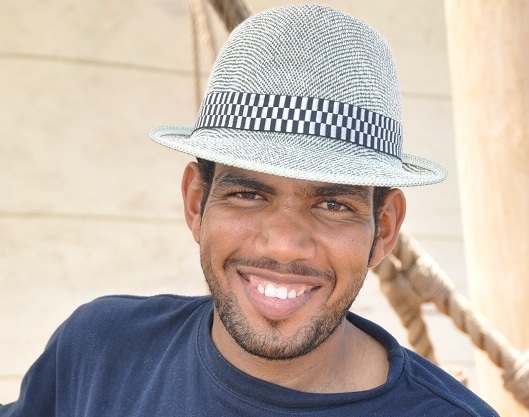
Fahad Al Shaibi
Growing up with the sea
21st May 2010
Fahad Al Shaibi
Fahad Al Shaibi tells the story of how he came to help build the Jewel and now sails on her as crew
My family comes from Sur and Qalhat in Oman so I grew up on the sea. My father was a fisherman before he entered the Army and I used to enjoy going out with him to set his nets. I still like to fish, but unfortunately the seas off Oman have been over-fished so there aren’t nearly as many fish today as there were ten years ago. This makes it hard to earn a living as a fisherman.
When it came time for me to decide what to do as a career, I chose to study carpentry at the Vocational Technical Center (VTC) in Seeb. At the time, I had no real interest in building boats, but after I had been at VTC for several years, a friend told me that a group of people in Qantab was planning to reconstruct an ancient Arab ship using a sewn-plank technique, and that they were looking for good carpenters. This was quite intriguing to me so I visited Qantab and met Dr. Tom Vosmer, the construction director, and expressed my interest in working on this ship. The next thing I knew, I was hired and I began building the vessel that would eventually be named the Jewel of Muscat.
I must say that the work was very difficult at times, but I liked what I was doing. I also knew I was learning a great deal every day about carpentry and shipbuilding. I especially enjoyed the challenge of helping to build the masts and the enormous quarter rudders. I even learned how to sew the heavy canvas sails.
After many months on the project, I was sent to Zanzibar for two months to learn how to make traditional sails out of palm-leaf mats. I had never been to Zanzibar and I enjoyed seeing such a beautiful country–and one that has played such an important role in Oman’s history. The only thing I didn’t like was contracting malaria, but I recovered from that fairly quickly. Someday I’d like to go back to Zanzibar–perhaps on a sailing ship.
At the time I was helping to build the Jewel of Muscat, I had no idea that I would eventually be able to become a member of its crew. But they needed carpenters on board, and when the ship was nearly complete, they asked me if I would like to sail to India. I was overjoyed at this invitation because I had come to really love this ship, and by becoming a crew member, I could combine my two great interests–the sea and carpentry. As it turned out, one of the other carpenters could not join the crew, so I was asked to sail not just to India, but all the way to Singapore. Of course I said ‘Yes’ immediately.
So far, the voyage has been an exciting adventure for me. Yes, it is dangerous at times and not very comfortable–and I miss my family very much–but I have learned so many new things and seen so many interesting sights that I know the hardships are worthwhile. In Sri Lanka I got to see a rain forest, beautiful green snakes, and monkeys – all for the first time. I also feel like my work is helping to make this voyage successful and that’s a good feeling. The other day, for example, we were taking on water because of the rain and high waves, and both manual pumps were broken. I was able to work with Ahmed Al Balushi to repair the pumps so we could remove the water from the ship and I felt proud of that contribution.
When this voyage is over, I would like to continue to expand my knowledge and develop my skills as a traditional boat builder. I’d like to build a Badan, a Battil, or even a large Boum of the kind in which Omanis once sailed all over the Indian Ocean. But until then, I am happy, proud, and very grateful to be aboard the Jewel of Muscat. It is a unique ship and everywhere we go people come to see it, take photos of it, and ask us about what it’s like to sail a 9th century ship. I know we still have a long way to go, but we are now half way across the Bay of Bengal and we shall continue to do our best as a crew. God willing, we shall arrive safely and on time in Singapore.
